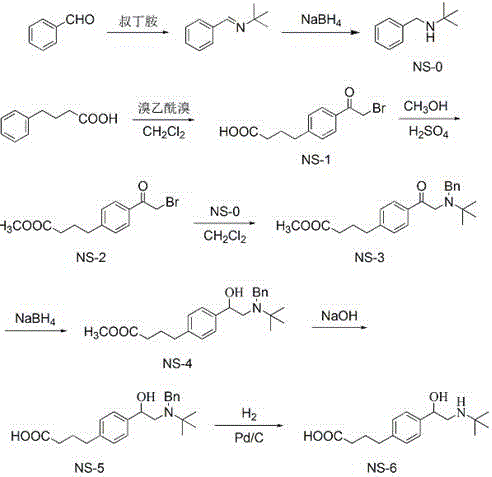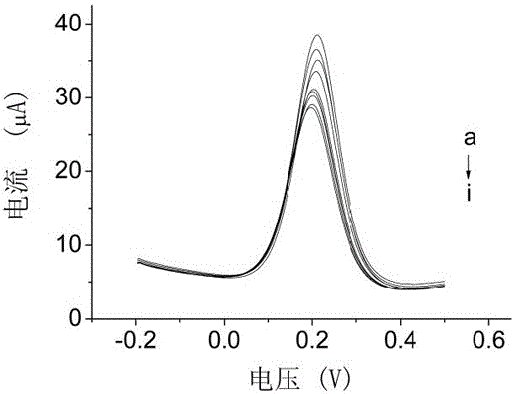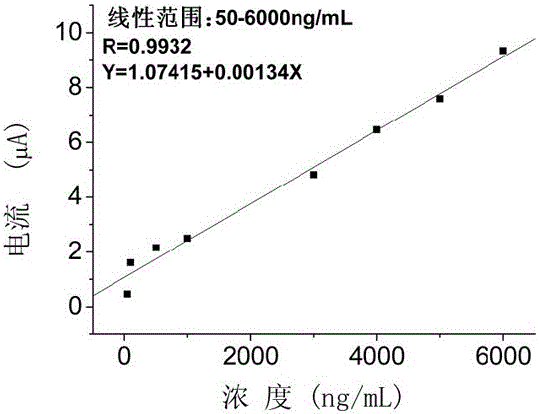Immune-electrochemistry sensor for detecting seven beta-adrenergic receptor agonists, and manufacture method and application of immune-electrochemistry sensor
A technology of receptor agonist and epinephrine, which is applied in the field of food safety detection and analytical chemistry, can solve the problems of complex operation, high cost of chromatographic detection, and easy occurrence of missed detection, and achieve simple detection operation, huge market potential, and practical strong value effect
- Summary
- Abstract
- Description
- Claims
- Application Information
AI Technical Summary
Problems solved by technology
Method used
Image
Examples
Embodiment 1
[0026] Synthesis of Example 1β-agonist universal hapten 4-(4-(2-tert-butylamino) 1-hydroxyethyl) phenylbutyric acid (TBPBA)
[0027] (1) Benzyl tert-butylamine (NS-0)
[0028] Dissolve 4.8ml of benzaldehyde in absolute ethanol, then add 5ml of tert-butylamine, react at room temperature for 2h, then add 1.8g of sodium borohydride for 1h. After extraction with dichloromethane, it was purified by silica gel column to obtain product NS-06.2g.
[0029] (2) 4-(4-Bromoacetyl)phenylbutanoic acid (NS-1)
[0030] Dissolve 8.56g of anhydrous aluminum chloride in dichloromethane, add 1.64ml of bromoacetyl bromide to react for 0.5h, then add 2.19g of 4-phenylbutyric acid to react for 3-5h. After extraction with dichloromethane and evaporation of the solvent, 3.5 g of the product were obtained.
[0031] (3) Methyl 4-(4-bromoacetyl)phenylbutyrate (NS-2)
[0032] Dissolve 2.85g NS-1 in methanol, add concentrated sulfuric acid and heat to reflux for 3h. The methanol was distilled off and ...
Embodiment 2
[0041] Embodiment 2 uses the preparation of hapten-bovine serum albumin (TBPBA-BSA) conjugate
[0042] Dissolve 0.2 mmol TBPBA in absolute ethanol, add an equal amount of N-hydroxysuccinimide (NHS) and 1-[3-(dimethylamino)propyl]-3 ethylcarbodiimide carbonate ( EDC), react at room temperature for 3 to 5 hours. The above reaction solution was slowly added to 5-10 ml of phosphate buffer solution containing 5-10 mg / ml bovine serum albumin (BSA), and reacted overnight at room temperature. The above reaction solution is dialyzed with phosphate buffer solution for 3 to 6 times, and freeze-dried to obtain the freeze-dried powder of TBPBA-BSA conjugate.
Embodiment 3
[0043] Preparation of embodiment 3 broad-spectrum specific antibody (anti-TBPBA-BSA antibody)
[0044] Healthy white rabbits weighing about 2 kg were immunized with TBPBA-BSA conjugates as immunogens. For the first immunization, 0.25 mg of immunogen was mixed with an equal amount of Freund's complete adjuvant, fully emulsified, and injected subcutaneously at multiple points on the back. Two weeks later, the same dose of immunogen and the same amount of Freund's incomplete adjuvant were used for emulsification and booster immunization, and booster immunization was performed every two weeks, for a total of three times. 10 days after the last immunization, blood was collected from the jugular vein of the white rabbits, placed at 4°C for 30 minutes, and then purified by ammonium sulfate multi-stage precipitation to obtain the anti-TBPBA-BSA polyclonal antibody.
PUM
| Property | Measurement | Unit |
|---|---|---|
| Volume | aaaaa | aaaaa |
| Concentration | aaaaa | aaaaa |
| Linear | aaaaa | aaaaa |
Abstract
Description
Claims
Application Information
 Login to View More
Login to View More - R&D
- Intellectual Property
- Life Sciences
- Materials
- Tech Scout
- Unparalleled Data Quality
- Higher Quality Content
- 60% Fewer Hallucinations
Browse by: Latest US Patents, China's latest patents, Technical Efficacy Thesaurus, Application Domain, Technology Topic, Popular Technical Reports.
© 2025 PatSnap. All rights reserved.Legal|Privacy policy|Modern Slavery Act Transparency Statement|Sitemap|About US| Contact US: help@patsnap.com



